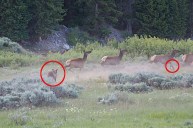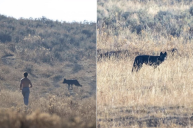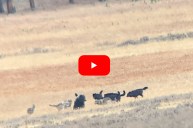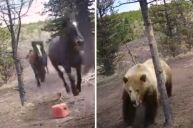The social media channel Tourons Of Yellowstone typically shares images and videos of tourists acting negligently inside national parks. Those tourist morons, or "tourons," usually trespass into dangerous areas or get too close to wildlife like grizzlies, elk, or bison. Flagrant violations of park rules. But a recent video has everyone especially angry.
In the video, five tourists are standing on a roadside near Beryl Spring, a hot spring in Yellowstone National Park, photographing a grizzly bear and her cubs grazing on a hillside. While it's typically "touron" behavior, a sixth person steps into the frame — what appears to be a professional photographer.
View this post on Instagram
While the status of the photographer is a mere presumption — he grabs a low angle from a kneeling position and uses a telescopic lens — he looks like a professional. In turn, many think that he should set an example rather than join the crowd in dangerous behavior.
Kaley Beausoleil, the wildlife photographer who took the video, wrote in the caption: "I'm especially mad at the photographer. You want to be a professional? Act like one! Teach people to respect wildlife and give them space."
And people commenting on the video seem to agree. "With a lens like that, you shouldn't need to be so close. Right?" said one person. "A real pro photographer with that lens would know they didn't need to be that close," said another. "That's a lot of glass at that distance. Maybe he's flexing his lens for the tourons," said yet another.
The dangers of getting too close to grizzly bears
Although bear attacks are rare, they do happen and they usually happen by accident or negligence. However, one surefire way to incite a grizzly attack is by getting too close to its cubs.
Last month, a hiker accidentally got too close to some grizzly cubs. As he hiked along Signal Mountain Trail, he saw a cub run across the trail from about 50 yards away and shortly thereafter, found himself face to face with a mama grizzly. He's lucky to be alive today.
Of course, visitors merely watching wildlife in controlled areas like viewing areas or roadways are often attacked because of negligence. That's why the National Park Service advises visitors to stay at least 25 yards away from animals like elk or bison and 50 yards away from predators like bears and wolves.




